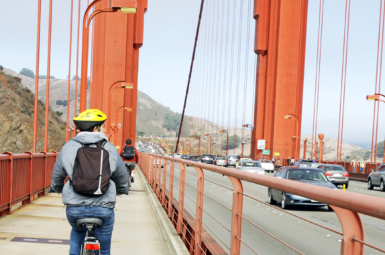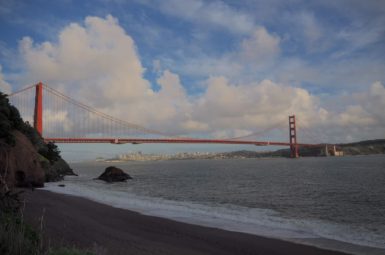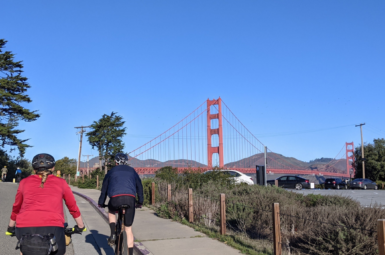Golden Gate Bridge The Golden Gate Bridge Speed Limit and Other Policy Changes
On November 18th, the Golden Gate Bridge District Board of Directors adopted a new set of policies resulting from the Bicycle Safety Study. This was widely publicized in the Marin IJ and the Chronicle, with heavy focus on the potential for riders being cited for speeding. While a new enforceable speed limit was indeed part of the new regulations, there are several other wins that we want folks to know about.
The Safety Study
This project came about because of the growing use of e-bikes on the bridge. Rather than regulate the type of electric bicycle that could use the bridge (e.g. allowing Classes 1 and 2, which have a top speed of 20 mph but prohibiting Class 3, which can reach up to 28 mph), the Bridge District sought to implement a speed limit.
This is in line with how we regulate cars – we don’t prohibit cars based on their top speed (though perhaps we should!) but rather limit their speed based on context. As supporters of e-bikes and boosters of their continued growth, we strongly supported a process to formalize their use on the bridge.
The Speed Limit
While a speed limit would not have been our first priority for improving safety for users of the Golden Gate Bridge, we did not take a stance against it. For one, the 15 mph speed limit is in line with other similar trails around the Bay Area, such as the Mill Valley-Sausalito Path, the Tiburon Rail Trail, and the Richmond-San Rafael Bridge. While most riders travel over the bridge at a very sensible speed, we’ve all seen people riding recklessly, and that should be discouraged to improve safety for other bike users and the pedestrians who share the east sidewalk.
What we do not want to see is letter-of-the-law sting operations in which cyclists are ticketed for traveling one or two miles per hour over the speed limit. While we have been reassured by bridge staff that this will not happen, if it does we want to be the first to know and encourage anyone to reach out.
Bicycle Pedestrian Advisory Committee
Many of the region’s transportation agencies (Caltrans, City of San Francisco, Marin County, BART, etc.) have what are called “Bicycle Pedestrian Advisory Committees,” or BPACs. These are groups of volunteers who serve a multi-year term and meet regularly to advise staff and the board on policy as it affects people walking or biking.
Up until now, the Golden Gate Bridge District did not have such a group. This despite the fact that thousands of people walk and bike across the bridge every single day, and committees did exist for Golden Gate Transit and Golden Gate Ferry riders.
After noticing this committee’s absence, we inquired as to why one did not exist. The only answer we found was that, apparently, no one had ever had the idea before. Happily, Bridge District staff incorporated it into their recommendations and work is now underway to establish the committee. We see this body as being very important in the long-term bikeability of the bridge. For example, the wind retrofit project we reported on this summer seems to have proceeded without anyone realizing the impact it would have for cyclists on windy days. Had a BPAC existed, this project would have been reviewed by it, and might have been designed differently.
While no decision has been made yet on who will serve on the BPAC or how appointments will be made, we will report on this when we have news.
Active Directional Signage
The rules that explain which sidewalk one can ride on are famously complex. Even when one has memorized the rules, construction often results in exceptions, requiring frustrating backtracking. One of MCBC’s long-running requests has been for variable message signage to actively direct bicycle users to the correct sidewalk.
At long last, this is in the process of being implemented, with signs on (nearly) all of the approaches letting people know which side they should use at the point they need to turn rather than only when they reach the gate.
Included in this item is a policy to permit cyclists to ride on the east sidewalk during high-wind events.
Crashes and Underreporting
The Golden Gate Bridge doesn’t just feel dangerous to ride – it is dangerous to ride, at least relative to other modes. According to the Bridge District’s own statistics, compared to driving, crossing the bridge by bicycle is 11 times more likely to result in a crash and 40 times as likely to cause an injury. This is, in our minds, an unacceptable disparity in a time when we need to encourage trips by bicycle.
What’s more, the reported crashes represent a substantial undercount of the actual number of crashes on the bridge, a finding backed up by our survey.
At our request, the Bridge District has implemented a tool to self-report bicycle crashes. While the link for the report is live (find it here) it is all but impossible to find on the website, and does not come up when you search “report a crash” on the site’s search bar. We are encouraging bridge staff to make the report tool more visible, ideally with something like QR codes that link to the survey clearly displayed on the bridge approaches.
Safety Goals
One request that went unfulfilled was the establishment of a safety goal for biking across the bridge. While the bicycle safety study cataloged the number of crashes occurring on the bridge, it made no recommendations that this number should be reduced, and set no metrics for success or failure of the policies it did recommend. We also felt that the analysis contained in the safety report was underwhelming and incomplete, and failed to make clear where and how the most severe crashes were occurring.
While we felt that this study would have been the time to establish safety goals for the sidewalk, staff said such goal setting would take place at a future date (see the Q&A for the staff report starting on page 77).
Moving Forward
While we feel that the safety study had some shortcomings, it should be noted that staff were helpful and responsive throughout the process, and did work to incorporate many of our recommendations. As it stood, the scope of this project limited recommendations to policy change rather than infrastructure.
Going forward, we hope and trust that the Bridge District will begin to view cyclists and pedestrians crossing the bridge as having the same weight and importance as drivers, and invest in infrastructural improvements accordingly. In the coming year the Bridge District will be developing its first master plan, and there will be opportunities to shape the direction and focus of that document.
sign-up for advocacy alerts
If you want to stay in the loop about developments specifically around the Golden Gate Bridge, fill out the form below.
members make it happen
We’re working to make Marin more bike-friendly for people of all ages and abilities. Are you with us?




